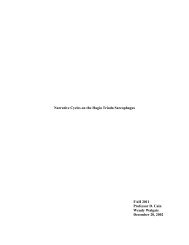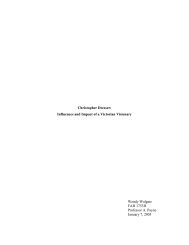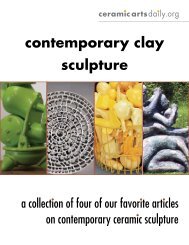You also want an ePaper? Increase the reach of your titles
YUMPU automatically turns print PDFs into web optimized ePapers that Google loves.
excess to return him to the relative safety of a Union Square hotel<br />
and the comfort of a Scotch on the rocks.<br />
The previous quote is a good description of the "gestalt" of my work during a first glance.<br />
The dizzying combination of brilliant colour, heavily laden surfaces, extravagant and<br />
precarious forms and a disturbing reference to some era other than the year 2000.<br />
The latest work has tried to soar, defy gravity more and to use surface as content in a<br />
more cohesive way. In the vase forms, the references to fountains and water are<br />
reinforced by the pouring, flowing glazes right down to the feet of the pot and on to the<br />
glaze shelf. I've learned to appreciate those puddles of glaze at the bottoms - I just round<br />
them off with a Dremel tool and let them stay there as part of the process.<br />
The upward movement of the work is counteracted by the gravity-pulled glaze. There is<br />
more conflict and visual interest in the work as the eye follows the movement up and<br />
down the surface. Particular colours such as a new explosive orange glaze and a red glaze<br />
with a visceral interior message, call for attention when placed strategically on the inside<br />
of goblet cups and the mouths of fountain-like attachments.<br />
The work demands constant scrutiny. There is always something more to learn from the<br />
surface. A glaze moment tucked behind a handle, an interior that is bathed with<br />
turquoise-jewelled glaze turned glass. The lip of a cup that curls back in a grin, two<br />
handles that impersonate ears. My work may confuse in the initial stage of introduction,<br />
but there is so much to be gained by having a conversation with it. They are complex,<br />
rich characters possessing very definite attitudes.<br />
Massimo Carboni, "Infinite Ornament" Art Forum, September<br />
1991 (pg. 106)<br />
Ornament is primarily for humans, almost a genetic impulse. It is<br />
not in the least optional. The desire to decorate, to create<br />
nonrepresentational forms, recalls luxury, waste and a gratuitous,<br />
nonuseful expenditure of energy. Ornament is inscribed within an<br />
economy of donation. It is a practice in which the subject loses its<br />
rationality, its self-legitimizing tendency, and falls into a<br />
dimension that recalls the etymological meaning of the Greek term<br />
"ek-stasis": to stand outside oneself.<br />
In tribal cultures, more care and skill go into the decoration of an<br />
object than into its efficiency as a tool. A fundamental property of<br />
ornament is that it is offered as a form of waste, luxury, excess,<br />
expenditure without compensation.<br />
18





